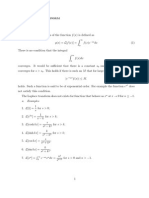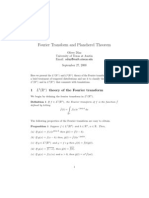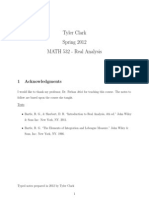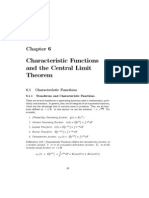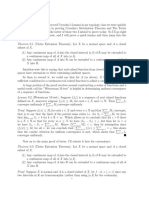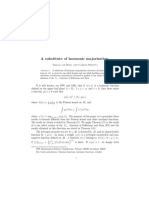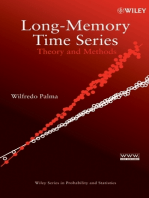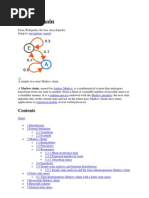Harmonic Analysis Lecture2
Harmonic Analysis Lecture2
Uploaded by
marchelo_cheloCopyright:
Available Formats
Harmonic Analysis Lecture2
Harmonic Analysis Lecture2
Uploaded by
marchelo_cheloOriginal Description:
Copyright
Available Formats
Share this document
Did you find this document useful?
Is this content inappropriate?
Copyright:
Available Formats
Harmonic Analysis Lecture2
Harmonic Analysis Lecture2
Uploaded by
marchelo_cheloCopyright:
Available Formats
2 Singular Integrals
We start with a very useful covering lemma.
Lemma 1. Suppose K S is a compact subset and I
is a covering of K.
There is a nite subcollection {I
j
} such that
1. {I
j
} are disjoint.
2. The intervals {3I
j
} that have the same midpoints as {I
j
} but three
times the lenghth cover K.
Proof. We rst choose a nite subcover. From the nite subcover we pick
the largest interval. In case of a tie pick any of the competing ones. Then, at
any stage, of the remaining intervals from our nite subcollection we pick the
largest one that is disjoint from the ones already picked. We stop when we
cannot pick any more. The collection that we end up with is clearly disjoint
and nite. Let x K. This is covered by one of the intervals I from our
nite subcollection covering K. If I was picked there is nothing to prove.
If I is not picked it must intersect some I
j
already picked. Let us look at
the rst such interval and call it I
j
. I is disjoint from all the previously
picked ones and I was passed over when we picked I
j
. Therefore inaddition
to intersecting I
j
, I is not larger than I
j
. Therefore 3I
j
I x.
This lemma is used in proving maximal inequalities. For instance, for the
Hardy-Littlewood maximal function we have
Theorem 1. Let f L
1
(S). Dene
M
f
(x) = sup
0<r<
2
1
2r
|yx|<r
|f(y)|dy (1)
[x : M
f
(x) > ]
3
|f(y)|dy
(2)
Proof. Let us denote by E
the set
E
= {x : M
f
(x) > }
6
and let K E
be an arbitrary compact set. For each x K there is an
interval I
x
such that
Ix
|f(y)|dy (I
x
)
Clearly {I
x
} is a covering of K and by lemma we get a nite disjoint sub
collection {I
j
} such that {3I
j
} covers K. Adding them up
|f(y)|dy
j
(I
j
)
1
3
j
(3I
j
) (K)
Sine K E
is arbitrary we are done.
There is no problem in replacing {x : |M
f
(x)| > } by {x : |M
f
(x)| }.
Replace by and let 0.
This theorem can be used to prove the Labesgue direntiability theorem.
Theorem 2. For any f L
1
(S),
lim
h0
1
2h
|xy|h
|f(y) f(x)|dy = 0 a.e. x (3)
Proof. It is sucient to prove that for any > 0
[x : limsup
h0
1
2h
|xy|h
|f(y) f(x)|dy ] = 0
Given > 0 we can write f = f
1
+g with f
1
continuous and g
1
and
[x : limsup
h0
1
2h
|xy|h
|f(y) f(x)|dy ]
= [x : limsup
h0
1
2h
|xy|h
|g(y) g(x)|dy ]
[x : sup
h>0
1
2h
|xy|h
|g(y) g(x)|dy ]
3h
1
Since > 0 is arbitrary we are done.
7
In other words the maximal inequality is useful to prove almost sure
convergence. Typically almost sure convergence will be obvious for a dense
set and the maximal inequality will be used to interchange limits in the
approximation.
Another summability method, like the Fejer sum that is often considred
is the Poisson sum
S(, x) =
n
a
n
|n|
e
inx
and the kernel corresponding to it is the Poisson kernel
p(, z) =
1
2
|n|
e
inz
=
1
2
1
2
(1 2 cos z +
2
)
(4)
so that
P(, x) =
f(y)p(, x y)dy
It is left as an exercise to prove that for for 1 p < , every f L
p
P(, ) f() in L
p
as 1. We will prove a maximal inequality for the
Poisson sum, so that as a consequence we will get the almost sure convergence
of P(, x) to f for every f in L
1
.
Theorem 3. For every f in L
1
[x : sup
0<1
P(, x) ]
Cf
1
(5)
Proof. The proof consists of estimating the Poisson maximal function in-
terms of the Hardy-Littlewood maximal function M
f
(x). We begin with
some simple estimates for the Poisson kernel p(, z).
p(, z) =
1
2
1
2
(1 )
2
+ 2(1 cos z)
1
2
1
2
(1 )
2
=
1
2
1 +
1
1
1
1
The problem therefore is only as 1. Lets us assume that
1
2
.
8
For any symmetric function (z) the intgral
|
f(z)(z)dz|
= |
0
[f(z) + f(z)](z)dz|
= |
0
(z)[
d
dz
z
z
f(y)dy]dz|
|
(z)[
z
z
f(y)dy]dz| +|()|
f(z)dz|
0
2|z
(z)|[
|f(y)|
z
(dy)]dz +()|
|f(z)|dz
2M
f
(0)
0
|z
(z)|dz +()||M
f
(0)|
For the Poisson kernel
|z
d
dz
p(, z)| =
1
2
1
2
(1 2 cos z +
2
)
2
2|z sin z|
(1 )z
2
(1 )
4
+ (1 cos z)
2
C
(1 )z
2
(1 )
4
+z
4
and
|z
d
dz
p(, z)|dz C
(1 )z
2
(1 )
4
+z
4
dz
=
1
1
z
2
1 +z
4
dz
z
2
1 +z
4
dz C
1
uniformly in .
Interpolation theorems play a very important role in Harmonic Analysis.
An example is the following
9
Theorem 4 (Marcinkiewicz). Let T be a sublinear map deened on L
p
L
q
that satises weak type inequlities
[|x| : |(Tf)(x)| ]
C
i
f
p
i
p
i
p
i
(6)
for i = 1, 2 where 1 p
1
< p
2
< . Then for p
1
< p < p
2
, there are
constants C
p
such that
Tf
p
C
p
f
p
(7)
Note that T need not be linear. It need only satisfy
|T(f +g)|(x) |Tf|(x) +|Tg|(x) (8)
Proof. Let p (p
1
, p
2
) be xed. For any function f L
p
and for any positive
number a we deine f
a
= f
{|f|a}
and f
a
=
{|f|>a}
. Clearly f
a
L
p
2
and
f
a
L
p
1
[x : |Tf(x)|| 2] [x : |Tf
a
(x)|| ] +[x : |Tf
a
(x)|| ]
C
2
p
2
|f(x)|a
|f(x)|
p
2
d +
C
1
p
1
|f(x)|>a
|f(x)|
p
1
d
Take a = , multiply by
p1
and integrate with respect to from 0 to .
Use Fubinis theorem. We get
p1
[x : |Tf(x)|| 2]d [
C
2
p
2
p
+
C
1
p p
1
]
|f(x)|
p
d (9)
Since the left hand side is
Tf
p
p
p
we are done.
There is a slight variation of the argument that allows p
2
to be innite pro-
vided T is bounded on L
. If we denote the norm by C
2
we use
[x : |Tf(x)|| (C + 1)] [x : |Tf
a
(x)|| ]
and proceed as before.
A dierent interpolation theorem for linear maps T is the following
10
Theorem 5 (Riesz-Thorin). If a linear map T is bounded from L
p
i
into
L
p
i
with a bound C
i
for i = 1, 2 then for p
1
p p
2
it is bounded from L
p
into L
p
with a bound C
p
that can be taken to be
C
p
= C
t
1
C
1t
2
(10)
where t is determined by
1
p
= t
1
p
1
+ (1 t)
1
p
2
(11)
Proof. The proof uses methods from the theory of functions of a complex
variable. The starting point is the maximum modulus principle. Let us
assume that u(z) is analytic in the open strip a < Rez < b and bounded
and continuous in the closed strip a Rez b. Let M(x) be the maximum
modulus of the function on the line Rez = x. Then log M(x) is a convex
function of x.This is not hard to see. Clearly the maximum principle dictates
that
M(x) max[M(a), M(b)]
If one is worried about the maximum being attained, one can always mutiply
by e
z
2
and let go to 0. Replacing u(z) by u(z)e
tz
yields the inequality
M(x) max[M(a)e
t(ax)
, M(b)e
t(bx)
]
optimizing with respect to t we get,
M(x) max[[M(a)]
bx
ba
, [M(b)]
xa
ba
]
which is the required convexity.
We note that the maximum of any collection of convex functions is again
convex. The proof is completed by representing log F(p), where F(p) is the
norm of T from L
p
to L
p
, as the supremum of a bunch of functions that are
11
convex in x =
1
p
.
T
p,p
= sup
fp1
gq1
|
g(Tf)d|
= sup
fp1,f0,||=1
gq1,g0,||=1
|
(g)(T(f))d|
= sup
f
1
1,f>0,||=1
g
1
1,g>0,||=1
|
(g
x
)(T(f
1x
))d|
= sup
f
1
1,f>0,||=1
g
1
1,g>0,||=1
Rez=x
|
(g
z
)(T(f
1z
))d|
= sup
f
1
1,f>0,||=1
g
1
1,g>0,||=1
sup
Rez=x
|u(f, g, , , z)|
In particular for the Hardy-Littlewood or Poisson maximal function the
L
bound is trivial and we now have a bound for the L
p
norm of the maximal
function in terms of the L
p
norm of the original function provided p > 1.
For a convolution operator of the form
(Tf)(x) =
f(y)k(x y)dy (12)
we saw that for it to be bounded as an operator from L
1
into itself we need
k to be in L
1
. However for 1 < p < the operator can some times be
bounded even if k is not in L
1
. This is proved by establishing a bound from
L
2
to L
2
and a weak type inequality in L
1
. We can then use Marcinkiewicz
interpolation, followed by Riesz-Thorin interpolation.
Theorem 6. If
k(n) =
e
inz
k(z)dz
is bounded in absolute value by C, then the convolution operator given by
equation (12) is bounded by C as an operator from L
2
to L
2
.
12
Proof. Use the the orthonormal basis e
inx
to diagonalize T
Te
inx
=
k(n)e
inx
(13)
We now proceed to establish weak type (1, 1) estimate. We shall assune that
we have a kernel k in L
1
that satises
1.
sup
n
|
k(y)e
iny
dy| = C
1
< (14)
2.
sup
y
x:|xy|>2|y|
|k(x y) k(x)|dx = C
2
< (15)
Although we have assumed that k is in L
1
we will prove a weak type (1, 1)
bound.
Theorem 7. The operator of convolution by k
(T
k
f)(x) =
k(x y)f(y)dy (16)
satises the weak type inequality (1,1)
[|x| : |(Tf)(x)| ]
C
f
1
(17)
with a constant C that depends only on C
1
and C
2
.
Proof. Proof involves several steps.
First we observe that the Hardy-Littlewood maximal function given
by (1) satises equation 2). The set G = [x : M
f
(x) ] is an open
set in [, ] and has Lebsgue measure atmost
3f
1
. We assume that
>
3f
1
2
so that B = G
c
is nonempty. We write the open set G as
a possible countable union of disjoint open intervals I
j
of length r
j
centered at x
j
. Note that the end points x
j
1
2
r
j
necessarily belong to
B. The maximal inequality assures us that
j
r
j
3f
1
13
Let us dene the averages
m
j
=
1
r
j
I
j
f(y)dy
and write f in the form
f(x) = [f(x)1
B
(x) +
j
m
j
1
I
j
(x)] +
j
[f(x) m
j
]1
I
j
(x)
= g(x) +
j
h
j
(x)
We have the bounds
|m
j
|
1
r
j
I
j
|f(y)|dy
1
r
j
I
j
|f(y)|dy
2
1
2r
j
I
j
|f(y)|dy 2M
f
(x
j
r
j
) 2
Here
I
j
is the interval centered around x
j
r
j
2
of length 2r
j
. In particular
g
2. On the other hand
j
h
j
1
=
I
j
|f(y) m
j
|dy 2
I
j
|f(y)|dy 2f
1
We therefore have
g
1
3f
1
Note that the decomposition depends on . Let us write the corre-
sponding sum
u = T
k
f = T
k
g +
j
T
k
h
j
= v +
j
w
j
= v +w
We estimate the L
2
norm of v and the L
1
norm of w on large enough
set. Then use Tchebychevs inequality.
[x : |v(x)|
2
]
v
2
2
2
C
1
g
2
2
2
2C
1
g
1
2
=
6C
1
f
1
14
Let us denote by
I
j
the interval centered around x
j
of length 3r
j
and
by U =
j
I
j
. We begin by estimating w.1
U
c
1
.
w.1
U
c
1
U
c
j
|
I
j
k(x y)[f(y) m
j
]dy|dx
=
U
c
j
|
I
j
[k(x y) k(x x
j
)][f(y) m
j
]dy|dx
U
c
I
j
|k(x y) k(x x
j
)||f(y) m
j
|dydx
=
I
j
|f(y) m
j
|dy
U
c
|k(x y) k(x x
j
)|dx
I
j
|f(y) m
j
|dy
I
c
j
|k(x y) k(x x
j
)|dx
I
j
|f(y) m
j
|dy
x:|xy|2|yx
j
|
|k(x y) k(x x
j
)|dx
C
2
I
j
|f(y) m
j
|dy
2C
2
f
1
We have used here two facts. f(y) m
j
has mean zero on I
j
. If y I
j
and x
I
c
j
, then |y x| r
j
2|y x
j
|. On the other hand
(U)
I
j
) 3
(I
j
) = 3
j
r
j
9f
1
Finally we can put the pieces together.
(x : |u(x)| 2) (x : |v(x)| ) + (x : |w(x)| )
6C
1
f
1
+
9f
1
+
2C
2
f
1
or
(x : |u(x)| )
(12C
1
+ 18 + 4C
2
)f
1
=
Cf
1
15
There is one point that we should note. For the interval doubling construction
on the circle we should be sure that we do not see for instance any interval
of lenghth larger than
2
in G. This can be ensured if we take >
6f
1
. The
inequality is however satised for all because C 12.
We want to look at the special kernel k(y) =
1
y
which is not in L
1
. We
consider its truncation
k
(y) =
1
y
1
{|y|}
(y)
First we estimate the Fourier transform
|
|y|
e
iny
y
dy| = 2|
sin ny
y
dy|
= 2|
n
n
sin y
y
dy| 4 sup
0<a<
|
a
0
sin y
y
dy| C
1
Next in order to verify the condition (15) we need to estimate the following
quantity uniformly in y and .
x:|xy|>2|y|
|k
(x y) k
(x)|dx
There are three sets over which the integral does not vanish.
F
1
= {x : |x y| > 2|y|, |x y| , |x| }
F
2
= {x : |x y| > 2|y|, |x y| , |x| }
F
3
= {x : |x y| > 2|y|, |x y| , |x| }
We consider
F
1
|
1
x y
1
x
|dx
x:|xy|2|y|
|
1
x y
1
x
|dx
|z1|2
|
1
z 1
1
z
|dz
= C
3
16
It is clear that F
2
[2, 2]. Therefore
F
2
1
|x|
dx 2
dx
x
= C
4
Finally F
3
[x : |x y| 2] and works similarly. With C
2
= C
3
+ 2C
4
we
are done.
We are now ready to prove
Theorem 8. For any f L
p
the partial sums s
N
(f, x) converge to f in L
p
provided 1 < p < .
Proof. We need only prove, for 1 < p < , a bound from L
p
to L
p
, for the
partial sum operators
(T
N
f)(x) =
f(x y)k
N
(y)dy
with
k
N
(z) =
1
2
sin(N +
1
2
)z
sin
z
2
that is uniform in N. In terms of multipliers we are looking at a uniform L
p
bound for the operators dened by
k
N
(n) = 1
{|n|N}
(n)
Let us dene the operators M
k
as multiplication by e
ikx
which are isometries
in every L
p
. P
0
is the operator of projection to constants, i.e. the operator
with multiplier 1
{0}
(n) which is clearly bounded in every L
p
. Finally the
Hilbert transform S is the one with multiplier signum n. It is easy to verify
that
T
N
= M
N
1
2
[(S +I) + P
0
]M
N
M
(N+1)
]
1
2
[(S +I) + P
0
]M
(N+1)
]
This reduces the problem to proving that a single operator S is bounded on
L
p
. The kernel is calculated to be
s(z) =
1
2
cot
z
2
This can be replaced by the modied kernel
k(z) =
1
z
and we are done.
17
You might also like
- Folland Chap 6 SolutionDocument23 pagesFolland Chap 6 Solutionnothard100% (4)
- YFC CampusBased ManualDocument188 pagesYFC CampusBased ManualMark Franz Templonuevo100% (2)
- Mock Trial Case 2018-19 Release EditionDocument147 pagesMock Trial Case 2018-19 Release EditionBen Tui0% (1)
- Functional Analysis Week03 PDFDocument16 pagesFunctional Analysis Week03 PDFGustavo Espínola MenaNo ratings yet
- The Vedangas FOR The First Time Reader BY N.Krishnaswamy: A Vidya Vrikshah PublicationDocument92 pagesThe Vedangas FOR The First Time Reader BY N.Krishnaswamy: A Vidya Vrikshah PublicationSaiKishore100% (3)
- Three Laws of RoboticsDocument2 pagesThree Laws of RoboticsBav VAansoqnuaetzNo ratings yet
- Notes March2002Document85 pagesNotes March2002Luis Alberto FuentesNo ratings yet
- Dependence Measures Bounding The Exploration Bias For General MeasurementsDocument7 pagesDependence Measures Bounding The Exploration Bias For General MeasurementsTsige TadesseNo ratings yet
- 4.Reisz-Thorin Interpolation TheoremDocument6 pages4.Reisz-Thorin Interpolation TheoremNikhil KumarNo ratings yet
- G(S) L (F (X) ) F (X) e DX: I. Laplace TransformDocument7 pagesG(S) L (F (X) ) F (X) e DX: I. Laplace TransformSnirPianoNo ratings yet
- Slides 1Document20 pagesSlides 1siNo ratings yet
- Quadratic Mean Differentiability ExampleDocument5 pagesQuadratic Mean Differentiability ExamplemamurtazaNo ratings yet
- LectureNotes CIMPAABIDJAN2014 PDFDocument30 pagesLectureNotes CIMPAABIDJAN2014 PDFPeronNo ratings yet
- Matrix Summability and Korovkin Type Approximation Theorem On Modular SpacesDocument12 pagesMatrix Summability and Korovkin Type Approximation Theorem On Modular SpacesSelin HAMAMCIYANNo ratings yet
- Course Notes Math 146Document10 pagesCourse Notes Math 146user2357No ratings yet
- Uniform Boundedness (Gliding Hump)Document6 pagesUniform Boundedness (Gliding Hump)rbb_l181No ratings yet
- O4MD 03 Descent MethodsDocument18 pagesO4MD 03 Descent MethodsSubhajit KunduNo ratings yet
- L10_Subgrad_PGD (partially annotated)Document39 pagesL10_Subgrad_PGD (partially annotated)Richardlim110No ratings yet
- Fourier Transform and Plancherel TheoremDocument34 pagesFourier Transform and Plancherel Theoremgogo222No ratings yet
- On the difference π (x) − li (x) : Christine LeeDocument41 pagesOn the difference π (x) − li (x) : Christine LeeKhokon GayenNo ratings yet
- Basic Properties of Metric and Normed SpacesDocument7 pagesBasic Properties of Metric and Normed SpacesBhopal NaikNo ratings yet
- BartleDocument11 pagesBartleLucius Adonai67% (3)
- L Spaces: 3.1 Banach and Hilbert SpacesDocument10 pagesL Spaces: 3.1 Banach and Hilbert SpacesGiovanny Der KaiserNo ratings yet
- Lecture Notes in Measure TheoryDocument7 pagesLecture Notes in Measure Theoryprimary111No ratings yet
- Foss Lecture3 AppendixDocument4 pagesFoss Lecture3 AppendixJarsen21No ratings yet
- Solved Problem StuffsDocument6 pagesSolved Problem StuffsMolinaNo ratings yet
- Uniform Continuity of Sinc XDocument8 pagesUniform Continuity of Sinc XOmaar Mustaine RattleheadNo ratings yet
- Introduction To Some Convergence Theorems: 2.1 RecapDocument7 pagesIntroduction To Some Convergence Theorems: 2.1 RecapAshoka VanjareNo ratings yet
- Wavelets With Compact SupportDocument11 pagesWavelets With Compact SupportAlinaKhayNo ratings yet
- Lecture Notes For Math 524: Chapter 1. Existence and Uniqueness TheoremsDocument14 pagesLecture Notes For Math 524: Chapter 1. Existence and Uniqueness TheoremsOsama Hamed0% (1)
- Functional Analysis Exam: N N + N NDocument3 pagesFunctional Analysis Exam: N N + N NLLászlóTóthNo ratings yet
- Chapt 6Document12 pagesChapt 6NewtoniXNo ratings yet
- On Weighted Inequalities For Singular IntegralsDocument8 pagesOn Weighted Inequalities For Singular IntegralsAlvaro CorvalanNo ratings yet
- Contractions: 3.1 Metric SpacesDocument10 pagesContractions: 3.1 Metric SpacesDaniel Sastoque BuitragoNo ratings yet
- James NotesDocument83 pagesJames NotesUmer HuzaifaNo ratings yet
- CharacteristicDocument9 pagesCharacteristicthanhptitNo ratings yet
- Improper IntegralDocument23 pagesImproper IntegralPblock Saher100% (1)
- STAT 538 Maximum Entropy Models C Marina Meil A Mmp@stat - Washington.eduDocument20 pagesSTAT 538 Maximum Entropy Models C Marina Meil A Mmp@stat - Washington.eduMatthew HagenNo ratings yet
- Hausdorff Dimension and FractalsDocument8 pagesHausdorff Dimension and FractalsAsad AbozedNo ratings yet
- Harmonic Analysis Lecture4Document8 pagesHarmonic Analysis Lecture4marchelo_cheloNo ratings yet
- NotesDocument73 pagesNotesgaurav_718676500No ratings yet
- HW2 SolDocument4 pagesHW2 Solprakrut kotechaNo ratings yet
- Topics in Analytic Number Theory, Lent 2013. Lecture 10: Summary of Zeros, Perron SummationDocument5 pagesTopics in Analytic Number Theory, Lent 2013. Lecture 10: Summary of Zeros, Perron SummationEric ParkerNo ratings yet
- Harmonic Analysis Lecture1Document6 pagesHarmonic Analysis Lecture1marchelo_cheloNo ratings yet
- Practice Final Exam Solutions: 2 SN CF N N N N 2 N N NDocument7 pagesPractice Final Exam Solutions: 2 SN CF N N N N 2 N N NGilberth Barrera OrtegaNo ratings yet
- Homework 4 SolutionsDocument7 pagesHomework 4 Solutionsstett100% (2)
- Dynamical SystemsDocument98 pagesDynamical Systemscharmingcf100% (1)
- Stable Manifold TheoremDocument7 pagesStable Manifold TheoremRicardo Miranda MartinsNo ratings yet
- HMWK 4Document5 pagesHMWK 4Jasmine NguyenNo ratings yet
- 2 Continuity, Differentiability and Taylor's Theorem: 2.1 Limits of Real Valued FunctionsDocument17 pages2 Continuity, Differentiability and Taylor's Theorem: 2.1 Limits of Real Valued FunctionsPblock Saher100% (1)
- fe2005Document16 pagesfe2005xoliqovasarvinozNo ratings yet
- Chapter 5Document19 pagesChapter 5chilledkarthikNo ratings yet
- Potential Theoretics Notions With Respect To A Multivalued Operator IDocument14 pagesPotential Theoretics Notions With Respect To A Multivalued Operator IEmil MoldoveanuNo ratings yet
- Sol 5Document4 pagesSol 5InstantRamenNo ratings yet
- Tietze ExtDocument3 pagesTietze Extdavid burrellNo ratings yet
- Soluciones Paso A Paso AnalDocument14 pagesSoluciones Paso A Paso Analchucky ozNo ratings yet
- Fall 2013 PDFDocument10 pagesFall 2013 PDFlopezmegoNo ratings yet
- A Substitute of Harmonic Majorization: - U (X, T) - P G (X)Document10 pagesA Substitute of Harmonic Majorization: - U (X, T) - P G (X)Alvaro CorvalanNo ratings yet
- Fixed Points of Multifunctions On Regular Cone Metric SpacesDocument7 pagesFixed Points of Multifunctions On Regular Cone Metric SpaceschikakeeyNo ratings yet
- Information Theory Differential EntropyDocument29 pagesInformation Theory Differential EntropyGaneshkumarmuthurajNo ratings yet
- Abstract Riemann SumDocument11 pagesAbstract Riemann SumAzhar UddinNo ratings yet
- MultispinDocument21 pagesMultispinAchraf LouizaNo ratings yet
- Exponential Dichotomy: Zhisheng Shuai Department of Mathematical and Statistical Sciences University of AlbertaDocument7 pagesExponential Dichotomy: Zhisheng Shuai Department of Mathematical and Statistical Sciences University of AlbertaoxxidNo ratings yet
- The Secure Aggregation Problem Algorithm Description Algorithm AnalysisDocument30 pagesThe Secure Aggregation Problem Algorithm Description Algorithm Analysismarchelo_cheloNo ratings yet
- Sistemas de Sensores en Red Lectura27Document4 pagesSistemas de Sensores en Red Lectura27marchelo_cheloNo ratings yet
- Lithium Batteries Science and TechnologyDocument766 pagesLithium Batteries Science and Technologymarchelo_cheloNo ratings yet
- A Study of Electro Materials For Lithium-Ion BatteriesDocument204 pagesA Study of Electro Materials For Lithium-Ion Batteriesmarchelo_cheloNo ratings yet
- Sistemas de Sensores en Red Lectura27Document4 pagesSistemas de Sensores en Red Lectura27marchelo_cheloNo ratings yet
- Sistemas de Sensores en Red Lectura26-ADocument19 pagesSistemas de Sensores en Red Lectura26-Amarchelo_cheloNo ratings yet
- Sistemas de Sensores en Red Lectura24Document20 pagesSistemas de Sensores en Red Lectura24marchelo_cheloNo ratings yet
- Sistemas de Sensores en Red Lectura26Document1 pageSistemas de Sensores en Red Lectura26marchelo_cheloNo ratings yet
- Sistemas de Sensores en Red Lectura21Document2 pagesSistemas de Sensores en Red Lectura21marchelo_cheloNo ratings yet
- Outline: Chris Karlof, Naveen Sastry, and David WagnerDocument22 pagesOutline: Chris Karlof, Naveen Sastry, and David Wagnermarchelo_cheloNo ratings yet
- Sistemas de Sensores en Red Lectura17Document5 pagesSistemas de Sensores en Red Lectura17marchelo_cheloNo ratings yet
- Sistemas de Sensores en Red Lecture19Document7 pagesSistemas de Sensores en Red Lecture19marchelo_cheloNo ratings yet
- Sistemas de Sensores en Red Lectura17Document5 pagesSistemas de Sensores en Red Lectura17marchelo_cheloNo ratings yet
- Sistemas de Sensores en Red Lecture10Document17 pagesSistemas de Sensores en Red Lecture10marchelo_cheloNo ratings yet
- Sistemas de Sensores en Red Lectura9-ADocument12 pagesSistemas de Sensores en Red Lectura9-Amarchelo_cheloNo ratings yet
- Sistemas de Sensores en Red Lectura9-CDocument26 pagesSistemas de Sensores en Red Lectura9-Cmarchelo_cheloNo ratings yet
- Promoting Student Motivation in EFL Classroom-A Perspective On The Role of TeacherDocument12 pagesPromoting Student Motivation in EFL Classroom-A Perspective On The Role of TeacherIJ-ELTS100% (1)
- Markov ChainDocument16 pagesMarkov Chainnaveenk903No ratings yet
- Mystery Method - The Easiest Way To Pick-Up - by SBDocument7 pagesMystery Method - The Easiest Way To Pick-Up - by SBFabricio Oliveira100% (1)
- 1669089542the Harvard MBA Business School Study On Goal SettingDocument6 pages1669089542the Harvard MBA Business School Study On Goal SettingNischal Singh AttriNo ratings yet
- 5.3 CaseStudy UniversalaDocument70 pages5.3 CaseStudy UniversalaianbanksNo ratings yet
- Ethical Dilemmas in The Information SocietyDocument227 pagesEthical Dilemmas in The Information SocietyEfthymios Hadjimichael100% (1)
- A Deleuzian Approach To Curriculum - Essays On A Pedagogical Life (Education, Psychoanalysis, and Social Transformation) - PDF Room-Páginas-14-26Document13 pagesA Deleuzian Approach To Curriculum - Essays On A Pedagogical Life (Education, Psychoanalysis, and Social Transformation) - PDF Room-Páginas-14-26leandraNo ratings yet
- Unit 6Document18 pagesUnit 6WaseemNo ratings yet
- Zetterberg, On Theory and Verification in SociologyDocument70 pagesZetterberg, On Theory and Verification in SociologyFlávia FrancoNo ratings yet
- Going A JourneyDocument10 pagesGoing A Journeyrabin dasNo ratings yet
- Nurs 440 Change ModelDocument2 pagesNurs 440 Change Modelapi-249918909No ratings yet
- English 10 1st and 2ndDocument9 pagesEnglish 10 1st and 2ndVince Rayos CailingNo ratings yet
- Cracow Siddhayogesvari and Various Vaisnava ThingsDocument87 pagesCracow Siddhayogesvari and Various Vaisnava ThingsJASON SCHWARTZ100% (1)
- T20 GE Investigating Corporate Mission and Vision StatementsDocument3 pagesT20 GE Investigating Corporate Mission and Vision StatementsOscar Pedro NavazNo ratings yet
- Pemat AvDocument4 pagesPemat AvNitaNo ratings yet
- Thuong Mai University Faculty of Marketing - Specializing in Brand ManagementDocument18 pagesThuong Mai University Faculty of Marketing - Specializing in Brand ManagementPhan DuyenNo ratings yet
- Wilson PDFDocument20 pagesWilson PDFHüseyin OrakNo ratings yet
- Chapter 7. Administring Scring Objctv Test and PaperDocument11 pagesChapter 7. Administring Scring Objctv Test and PaperRegina PalisocNo ratings yet
- Eli K-1 Lesson 1Document6 pagesEli K-1 Lesson 1ENo ratings yet
- Guide To Auditing The Quality Management SystemDocument23 pagesGuide To Auditing The Quality Management SystemAzrul Akiff Azman100% (1)
- 耶鲁大学公开课-死亡哲学 阅读材料整理Document10 pages耶鲁大学公开课-死亡哲学 阅读材料整理vmmmzhuanyongNo ratings yet
- Plutarch Life of Demetrius 2015Document373 pagesPlutarch Life of Demetrius 2015ivanNo ratings yet
- SYNTAX SYLLABUS Compiled and Edited by PDFDocument43 pagesSYNTAX SYLLABUS Compiled and Edited by PDFPhan ThongNo ratings yet
- Ethical & Legal Responsibilities in NursingDocument26 pagesEthical & Legal Responsibilities in NursingYounas Bhatti100% (1)
- A Guide For Professional Journalism in Conflict Zones English PDFDocument60 pagesA Guide For Professional Journalism in Conflict Zones English PDFJamy MartínezNo ratings yet
- Kherad e Shad JamaliDocument153 pagesKherad e Shad JamalimezghoonNo ratings yet









